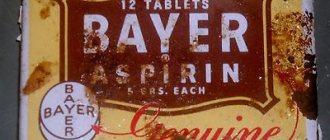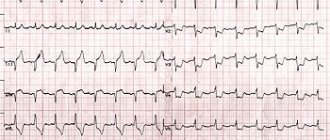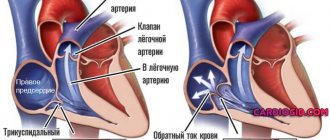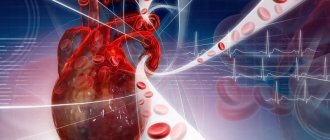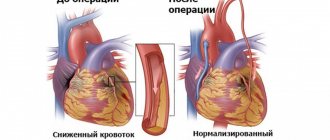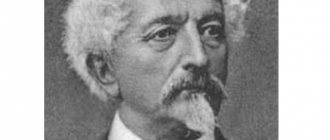DlyaSerdca → Heart Diseases → Ischemia → Traditional methods and recipes in the treatment of coronary heart disease
Coronary heart disease (angina pectoris, cardiosclerosis) causes spasmodic pain in the heart area. This disease has a chronic course. Exacerbation of the disease can cause myocardial infarction.
Therefore, this disease is very dangerous, and the sooner it is diagnosed and treatment is started on time, the better.
IHD is caused by impaired blood supply to the heart due to narrowing of the patency of the coronary arteries.
This mainly happens due to sclerosis or vascular thrombosis. The disease may not make itself felt for a long time. Mostly, people go to the doctor when they feel heart pain, arrhythmia of the heart rate and surges in blood pressure.
Vascular atherosclerosis
You need to consult a doctor and conduct a full diagnosis if signs of coronary heart disease appear. The doctor will be able to determine the stage of the disease and prescribe medication, physiotherapy and exercise therapy. In addition to traditional medicine, there are many folk remedies and methods for treating coronary artery disease.
The role of a healthy lifestyle in the prevention and treatment of coronary artery disease
One of the causes of IHD is physical inactivity and excessive consumption of fatty, high-calorie foods, and hence excess weight. Therefore, at any age you need to adhere to an active lifestyle.
In order to keep the body in good shape, it is enough to take walks in the evenings, or go skiing and skating in the winter.
All this must be done calmly and with pleasure. Swimming has a good effect. Now you can swim all year round because swimming pools are available to everyone. It is useful to do yoga and breathing exercises.
Excess weight is a big burden on the heart and the entire body as a whole. This means that it is imperative to control what food we eat and in what quantity. Coronary heart disease is a poor patency of the blood vessels supplying blood to the heart muscle. Therefore, you need to eat foods that do not contain bad cholesterol.
Cholesterol plaques in blood vessels
Cholesterol is poorly excreted, forms cholesterol plaques, they settle on the walls of blood vessels, clogging them, impairing patency. The menu should consist mainly of vegetables and fruits, lean meat, and fish. It is advisable to cook by steaming or using vegetable oil. It is better if the food is under-salted than over-salted.
“Calm, just calm,” as the famous cartoon character Carlson said. And he was, of course, right. IHD is very dependent on calmness. Nervous stress affects the functioning of the heart. Learn to enjoy the little things and be happy, know how to relax. Good for this are picking mushrooms, fishing, drawing.
"Heart" products
- Banana . Regular consumption of this fruit can reduce the likelihood of developing myocardial infarction or stroke and helps normalize blood pressure. Banana is a storehouse of vitamins and useful elements; it contains: B vitamins, phosphorus, sodium, iron, calcium, carotene, magnesium and potassium. This fruit is truly a friend of the heart; it is almost a champion in potassium content. Banana will not only strengthen the heart muscle, but also fight the formation of cholesterol plaques, thereby protecting blood vessels.
Dried apricots . It is not only very tasty, but also very healthy, especially for the heart. It contains potassium, magnesium, calcium, carotene, pectin, iron, phosphorus, and many vitamins. This dried fruit will strengthen the nervous system, immunity, and increase hemoglobin levels. Dried apricot normalizes blood pressure, inhibits the development of atherosclerosis, cleanses blood vessels of cholesterol, improves blood circulation, and makes the main muscle in the human body more resilient.- Honey _ The affected myocardium can replenish its strength with glucose, which is found in abundance in honey. It promotes the expansion of coronary vessels, improving blood flow in them. A small amount of honey, when used regularly, can improve blood composition and increase muscle tone of the heart. Honey removes swelling, helps with shortness of breath, and relieves attacks of arrhythmia. It is also rich in B vitamins; A, E, C, H, K, potassium, magnesium, copper, fluorine, calcium, zinc, manganese, boron, iron, chromium.
- Walnut . It contains a lot of potassium, it is able to protect the nervous system, increase the endurance of the heart, bring its rhythm back to normal, lower blood pressure, minimize the possibility of blood clots, and get rid of cholesterol. Walnuts contain a lot of unsaturated omega-3 fats (reduce cholesterol, improve heart rate), vitamin E, fiber, protein, and the amino acid l-arginine, which makes blood vessels more elastic.
Products that are used in the treatment of this disease
You can treat IHD at home by eating certain foods.
Fish fat. This product contains Omega-3 polyunsaturated acids. Saturating the body with these acids removes cholesterol and makes blood vessels elastic. Therefore, it is an indispensable tool in the treatment and prevention of coronary artery disease. Fish oil is now sold in capsules, so you can drink it without experiencing a nasty taste or smell. You can buy fish oil with vitamin “E” or with motherwort and valerian, there are other fillers. In addition, fish oil promotes weight loss and removes fat. Dosages are indicated on the package.- Cottage cheese. It is recommended to eat 100 grams of cottage cheese per day and this is very helpful in treating heart ischemia. Only it is advisable to buy real cottage cheese, in the private sector. Or make it yourself from real milk.
Kalina. Fresh or steamed, together with seeds, it is an excellent remedy for the treatment of coronary artery disease. Viburnum by itself is not tasty, you need to eat it with honey, especially since honey itself is involved in many folk recipes for the treatment of cardiac ischemia.- Tea. If you have cardiac ischemia, it is better to give up black tea and coffee. You should drink green tea. It is good to brew a tea drink from your garden. You can use lemon balm, mint, raspberry or currant leaves in the tea. In the villages they always drank tea made from oregano and St. John's wort. All these teas are pleasant to drink; you can drink them constantly, replacing “harmful” drinks with them. You can add lemon and honey to this tea for taste, the effect will be even better.
- Millet porridge. Eat millet porridge as often as possible. This cereal contains a lot of potassium, and potassium is very important for heart function. It’s worth loving this porridge and eating at least a little every day.
Nuts and dried fruits. It is very useful for IHD to eat nuts, especially nutmeg with milk. Dried apricots and raisins are delicious and also healthy folk remedies for the heart. It’s good to cook dried fruit compote and drink.- Strawberries. People say: Anyone who has heart disease should eat 3 kg of fresh wild strawberries during the season. You can dry strawberries for the winter and brew them with boiling water, leave for 3 hours, and drink along with the pulp.
Properties of herbs
A visit to the doctor will help eliminate heart problems, but traditional medicine can be successfully supplemented with alternative medicine.
If the patient has recently become concerned about coronary heart disease, treatment with folk remedies will be very advisable. Why do heart patients turn to traditional medicine for help? Many believe in the healing power of nature and the wisdom of the people, who from time immemorial have used this power for their own benefit. Time-tested recipes are credited with magical properties, but the successful treatment of cardiac ischemia with folk remedies has a completely scientific explanation.
The plant world is rich in beneficial substances that can improve the functioning of the heart and blood vessels.
Medicines that are used in traditional medicine are made from plant extracts. Vitamins and microelements contained in certain foods, vegetables, and fruits help strengthen the heart muscle.
Plants that can be used to treat coronary heart disease:
- hawthorn;
- motherwort;
- peppermint;
- fennel;
- rose hip;
- pharmaceutical camomile;
- Melissa;
- valerian;
- horsetail;
- Eleutherococcus
This is not a complete list of medicinal herbs. Some strengthen the heart, others relieve symptoms of arrhythmia, pain, calm the nervous system, lower blood pressure, and fight swelling. Often all these medicinal properties are combined in one plant.
Here are descriptions of some herbs and their beneficial properties.
Hawthorn . The plant helps the heart contract more strongly, activates blood flow in the vessels that supply the heart, and can relieve attacks of arrhythmia. Hawthorn has a beneficial effect on the nervous system and relieves pain accompanying angina pectoris. It contains hyperin (an antioxidant), which protects blood vessels from damage and prevents the development of atherosclerosis.- Rose hip . Contains a lot of useful things: vitamins and microelements. It will strengthen blood vessels and prevent atherosclerotic phenomena. Rosehip promotes active hematopoiesis and lowers blood pressure.
- Melissa . It is used for hypertension and also as a sedative. The composition includes vitamins B and C, microelements (copper, zinc, selenium, calcium, manganese), including magnesium and potassium, which are especially beneficial for the heart. Melissa fights anemia, relieves heart pain, eliminates dizziness, improves heart rhythm, and improves blood circulation.
- Horsetail . This is a good remedy for edema, including cardiac edema. The plant has a pronounced diuretic property, normalizes metabolic processes, relieves inflammation, helps stop internal bleeding, and fights atherosclerosis of the heart vessels. Horsetail is rich in the following beneficial substances: magnesium, manganese, potassium, selenium, iodine, carotene, zinc, iron, vitamin C.
Magnesium and potassium are very useful for the normal functioning of the heart and blood vessels. They:
- Provide nutrition to the heart.
- Activate the process of hematopoiesis.
- Adjusts the rhythm of heart contractions.
- Promotes blood thinning and increases blood circulation.
- Prevents the formation of blood clots.
- Reduce atherosclerotic plaques.
- Strengthens blood vessels and promotes the elasticity of their walls.
- Eliminate pain in the heart muscle.
It is not for nothing that traditional medicine recommends consuming foods containing magnesium and potassium for the treatment of ischemic heart disease.
Here are some of them: raisins, dried apricots, banana, walnuts, beans, buckwheat, honey. There are many recipes for treating heart disease that contain these beneficial foods.
Herbal medicine: herbal infusions
Treat IHD with folk remedies, making infusions of herbs and herbal infusions, recipes:
Unique herb Astragalus woolly-flowered. A tablespoon of dried astragalus is brewed in 300 ml of boiling water, wrapped and left overnight. Drink 100 ml of the product 20 minutes before meals, 3 times a day. An infusion of Astragalus wooliflora is taken for hypertension, angina pectoris (IHD), heart disease, cardiovascular failure with a tendency to spasms of the coronary vessels. The infusion perfectly stabilizes blood pressure. You can drink all the time.- Birch earrings. Collect flowering birch catkins from the branches. Pour in 2/3 of the jar of earrings and fill to the top with vodka. The jar is removed to infuse for 2 weeks. The product is taken 1 teaspoon with water, 3 times a day, before meals. Drink the infusion for 2 months. Heart pain is treated, shortness of breath goes away. Vigor appears, hemoglobin increases.
Fennel. Fennel seeds 10 grams, brew a glass of boiling water and let it brew until it cools. Drink before meals, you can add a spoonful of honey and an alcohol infusion of valerian.- Honey with garlic. Make a paste of 250 grams of garlic and add 350 grams of honey. Mix everything and leave for a week. Take a tablespoon 2 times a day, half an hour before meals. You can add lemon juice to the infusion.
- Dill. Making dill water is easy. Chop fresh dill or take seeds. Brew a handful of dill in 300 ml of water. Tincture, take before meals. Drink in a day.
- Hawthorn. Brew a handful of dried hawthorn fruits with a glass of boiling water and leave for a couple of hours. Drink before meals 4 times a day, 2 tablespoons.
Nettle. Brew a couple of tablespoons of nettle with a glass of boiling water and drink throughout the day. You can add lemon juice and honey.- For pain in the heart. Brew two handfuls of woodlice herb in 0.5 liters of boiling water, wrap and leave until it cools completely. Drink half a glass 4 times a day 30 minutes before meals for a month.
- Collection 1. Pour 6 spoons of motherwort into a jar, the same amount of hawthorn and rose hips. The mixture is poured into 2 liters of boiling water. The infusion is taken in a glass before meals.
- Collection 2. Make a mixture of hawthorn flowers, chamomile in equal parts and a little more motherwort. Brew a tablespoon of the collection in 0.5 cups of boiling water and let it brew until it cools. Take 4 times a day before meals.
Especially in the treatment of IHD with folk remedies, I would like to highlight honey. Perhaps this is the most unique remedy, because honey is present in almost every recipe.
Even if honey is not listed in the recipe, you can add it to your benefit.
Classification of IHD
Coronary heart disease is divided into several types:
- Sudden coronary death - death occurs instantly or within an hour after the onset of a heart attack.
- Heart failure . Develops as a result of prolonged insufficiency of blood supply to the myocardium. Manifested by shortness of breath and swelling.
- Angina pectoris. This is one of the types of ischemic heart disease, which is manifested by pain and discomfort in the chest of a pressing, squeezing nature. The pain is localized behind the sternum and can radiate to the neck, left arm, epigastric region, and lower jaw. There are the following main types of angina:
- angina pectoris – pain in the heart occurs during physical exertion;
- Spontaneous angina - pain occurs against the background of the patient’s usual stress or at rest, the attack lasts more than twenty minutes.
- Violation of the rhythm and conductivity of the heart (tachycardia, bradycardia, arrhythmia).
- Painless coronary heart disease . A latent form of the disease that can only be detected using instrumental diagnostic methods.
- Post-infarction cardiosclerosis . Myocardial damage, in which the muscle tissue of the heart is replaced by scar tissue.
- Myocardial infarction . Death of a part of the heart, which occurs as a result of an acute circulatory disorder in it.
- Syndrome X. A variant of coronary artery disease in which angina attacks are observed with unchanged large coronary vessels; pathological changes in this form of the disease develop in small arteries.
In addition, there are acute forms of IHD (myocardial infarction, focal acute dystrophy, unstable angina) and chronic forms of IHD (painless form of the disease, cardiac arrhythmias, stable angina).
Development of edema
Patients suffering from heart failure need to know that as the disease progresses, all accompanying symptoms worsen. If at the first stages of the disease the accumulation of fluid in the body is insignificant, then over time, this symptom manifests itself more and more. Patients are mistaken in believing that edema due to heart failure is a temporary phenomenon. Often, fluid accumulation in the legs is associated with fatigue. After all, after rest, the condition of the lower extremities improves, and the patient does not experience discomfort. But, over time, the disease progresses, and the accumulation of fluid does not seem so harmless. Legs swell not only at the end of the working day; this condition occurs at any time of the day, regardless of physical activity. Along with this condition, the patient notes a deterioration in health and the appearance of other symptoms of the disease.
Diagnosis of coronary heart disease
The diagnosis is established based on the patient’s complaints and symptoms, risk factors, as well as additional examination methods:
- ECG at rest and with physical activity;
- cardiac echocardiography (Echo-CG);
- clinical and biochemical blood tests;
- angiocardiography is an x-ray examination with the introduction of a contrast agent into the vessels of the heart.
These methods make it possible to assess the degree of patency of the coronary vessels and the presence of functional changes in the heart muscle.
Symptoms of IHD
Clinical manifestations depend on the form of the disease . Common symptoms include the undulating course of IHD, when periods of normal well-being alternate with periods of exacerbation of the disease.
About a third of patients do not experience any symptoms at all . IHD can develop over decades and certain symptoms can appear just as slowly.
The main clinical signs of IHD are:
- arrhythmia;
- feeling of constriction in the heart area;
- physical weakness;
- shortness of breath, which occurs with light exertion and even at rest;
- nausea;
- feeling of lack of air;
- cold clammy sweat.
With angina pectoris, the patient feels intense paroxysmal pain that does not last long and a feeling of strong compression in the chest (which is why angina pectoris is popularly called “angina pectoris”).
In addition, with coronary artery disease, the patient feels causeless anxiety, he develops a fear of death, a state of apathy and melancholy.
Attacks of spontaneous angina, unlike exertional angina, can occur suddenly, for example, while taking a shower or leaving a warm apartment into the cold.
In case of sudden coronary death, a person suddenly loses consciousness, his heart sounds cannot be heard, there is no pulse, breathing stops, his pupils dilate, and his skin acquires a grayish tint.
